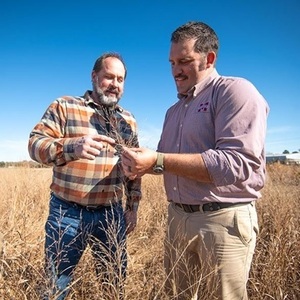Three Mississippi State-bred switchgrasses hit the market

SOURCE: David Ammon
September 1, 2022
BY Mississippi State University
Mississippi State scientists have developed switchgrass varieties that are waking up the industry with exceptional germination rates and are ready for commercial use in the Deep South.
Switchgrass is used for biofuels, soil and water conservation and carbon sequestration.
The university is working with the Upton, Kentucky-based Roundstone Native Seed Co. to deliver the “Robusto,” “Espresso,” and “Tusca” switchgrass varieties, developed by scientists in MSU’s Mississippi Agricultural and Forestry Experiment Station. In addition, Plant Variety Protection—similar to a patent for newly bred varieties—has been awarded for Espresso and is in review for Robusto. Tusca is protected by a utility patent and officially released by MAFES.
The origins of these coffee-inspired switchgrass varieties can be traced to the 20-year-old harvest from the Whitten Plant Materials Center in Coffeeville, whose living repository contained seeds from Mississippi, Arkansas, Louisiana and Alabama. In 2003, the Whitten Center changed its focus and sent its collection to MSU. Living plants were transplanted from Coffeeville to the R.R. Foil Plant Science Center, commonly known as MSU’s North Farm, and the first generation of selection blocks for research were established.
Professor Brian Baldwin, Associate Extension and Research Professor Brett Rushing, and Assistant Research Professor Jesse Morrison, all MAFES scientists in the Department of Plant and Soil Sciences, have co-developed these varieties over the last 15 years to increase germination rates and reduce seed dormancy. Their focus, which has little historic precedence, has been breeding varieties of native grasses that are adapted to the humid Southeast.
“The varieties of switchgrass that are commercially available come from Illinois, Nebraska or Texas, so none of them are truly adapted to the Deep South,” Baldwin said.
Advertisement
Advertisement
The most adverse trait of North American native grasses, according to Baldwin, is their high seed dormancy, which means that most of the seeds planted fail to germinate even in optimal growth conditions. The dormancy period may last as long as five years in some native grass species.
“Native grasses have a strong seed dormancy, and that works well in natural conditions,” Baldwin said. “But in restoration work, if you want to change an old pasture into native grass you want all the seeds to germinate quickly.”
Rushing added, “Conservation plantings are the main target of this grass type. Parks and public lands, where switchgrass is used for erosion control and wildlife forage, are the ideal settings.”
Robusto, an upland variety, and Espresso, a lowland variety, were specifically bred to address the low germination rates. Upland switchgrass is typically found in drier environments and shallow soils, and they have potential use in conservation and forage plantings. In contrast, lowland switchgrass is taller than the average human and typically used for biofuel, a renewable alternative energy source.
To test the consistency of the seeds’ germination velocity, weekly field evaluations were conducted at various sites throughout Mississippi, including Starkville, Brooksville, Poplarville, Newton and Holly Springs, all differing in climate and/or soil type. Both Robusto and Espresso held a consistent germination velocity at all test sites, germinating at least double the number of seeds as the leading commercial varieties in 14 days.
The release of Tusca, a lowland switchgrass, meets the equally critical need of a naturally occurring herbicide resistance variety. When tested at various growth stages with five commonly used herbicides, Tusca resisted injury with the application of all five, outperforming another commercially available switchgrass which was used for comparison.
Advertisement
Advertisement
“Weed control is a serious limiting factor in establishing a perennial native species. The release of Tusca is based on a need for locally adapted germplasm that has the enhanced herbicide resistance found in other native grass species,” Baldwin said.
Together, these three switchgrass varieties offer superior commercial options for clientele throughout the Southeastern United States.
Seed requests for research purposes, such as variety testing, should be sent to Brian Baldwin in the Department of Plant and Soil Sciences at bsb2@msstate.edu.
For more about MAFES, visit www.mafes.msstate.edu.
MSU is Mississippi’s leading university, available online at www.msstate.edu.
Related Stories
Broco Energy on July 17 announced a new partnership with the Massachusetts Port Authority (Massport) to deliver and transition Massport's fuel tanks to renewable diesel across its various facilities.
Shell Aviation, Accenture, and Amex GBT on July 10 announced Avelia is in the process of evolving to an industry solution with independent data hosting and a multi-supplier model helping users access the GHG benefits of SAF.
The U.S EPA on July 17 released data showing more than 1.9 billion RINs were generated under the RFS during June, down 11% when compared to the same month of last year. Total RIN generation for the first half of 2025 reached 11.17 billion.
The U.S. EPA on July 17 published updated small refinery exemption (SRE) data, reporting that six new SRE petitions have been filed under the RFS during the past month. A total of 195 SRE petitions are now pending.
European biodiesel producer Greenergy on July 10 confirmed plans to shut down its biodiesel plant in Immingham, Lincolnshire, U.K. The company temporarily suspended operations at the facility earlier this year.
Upcoming Events










